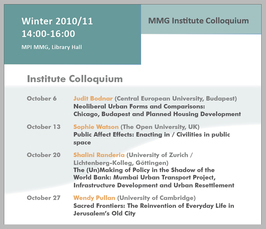"Intersections between Indian and Chinese Vernacular Urbanisms"
Institute Colloquium Winter 2010/11
- Datum: 22.09.2010
- Uhrzeit: 14:00 - 16:00
- Vortragender: Solomon Benjamin (National Institute for Advanced Study, Bangalore)
- Solomon Benjamin is an Associate Professor at the Bangalore based, National Institute of Advanced Studies and co-anchor of a newly established Urban Research and Policy Program (URPP). Benjamin’s doctoral work at Massachusetts Institute of Technology’s Department of Urban Studies and Planning (1996) looked at the politics of land and small firms in East Delhi. His present research looks at globalization as it shaped city politics, economy and land.
- Ort: MPI-MMG, Hermann-Föge-Weg 11, Göttingen
- Raum: Library Hall

For more details please contact esser(at)mmg.mpg.de.
Three aspects interlink Indian and Chinese urbanisms: Trading relationships reflected in the ‘China-bazaars’ of Indian cities and towns linking those to East China’s manufacturing towns and cities; Second, the seemingly banal land setting circumvent, often defy Master Planning’s disciplinary land-use zoning; Third, scruffy looking traders flying economy class. Two inter-related types of substantial issues underpin these connections and mobilities – between Delhi’s Gaffar Market for instance, and Zhejiang Province’s Yiwu. The first relates to the disruption of singular forms of property into multiple forms make possible an economy of intense innovation around customization and reverse engineering. This disruption is reflected in diverse land tenures and occupancy claims, and also allows for an autonomous institutional politics empowering local government. Such fluidity in regulations allows us to consider institutional spaces occupied by a world of touts, liaison agents, and courier companies, whose systemic relationships form the material underpinnings of trans-urban mobility.
My traverses through Indian and China’s vernacular urbanisms (with slight diversions to the Himalayan highlands of Sikkim and Yunan) help us think about globalization very differently than that witnessed in Beijing and Shanghai’s “High Modernism”, or then, Bangalore’s IT corridor. Today, post the global financial crises, with that model of developmentalism being shaken if not fractured, should we take such connections more seriously?